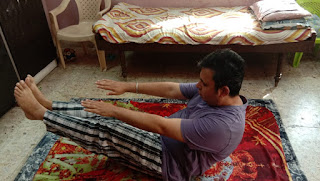Apana Mudra for Digestion and Body Detoxification
 |
| Apana Mudra for Digestion and Body Detoxification |
Apana mudra is also known as purification mudra. It is a hand gesture that detoxifies and purifies the body. It balances the elements of space and earth within it. It eliminates water, toxins and chemicals in the body. It prevents diseases and illnesses.
As per Hindu and Buddhist philosophy whole universe, human body is made of Fire, Air, Space, Earth and Water. Our Five fingers represent all these five elements.
Thumb denotes Fire, Index Finger denotes Air, Middle Finger denotes Space, Ring Finger denotes Earth and Little finger denotes Water.
Imbalance in any of five elements can disturb our immune system to make our body an easy target for various physical and mental disorders.
By doing hand mudras, we can re-establish the balance among these 5 elements in our body for health and happiness.
Hand Mudras direct the flow of energy in our body in a manner to produce the desired therapeutic benefit.
How to do Apana Mudra
- Apana Mudra is done by bending the middle finger, ring finger and the thumb. Tip of all these fingers should be touching each other.
- Index and little finger should remain fairly straight.
- It can be practiced sitting cross legged, walking or lying down. For better results it can be done by sitting in Vajrasana pose. Vajrasana helps in digestion by increasing the flow of blood to the pelvis.
- This mudra should be practiced with both the hands.
- It should be practiced 30 to 45 minutes or three times a day for 10 to 15 minutes.
- It is good to practice this mudra in the morning.
People with vata and kapha constitution should practice Apana Mudra in moderation.
Benefits of Apana Mudra
- Apana Mudra is also called as cleansing or energy mudra. It brings about energy in the liver and gallbladder. It supports balance and harmony.
- It helps in body detox and digestion by stimulating the excretion system to flush out toxins off the body. So it is also called as mudra for digestion and detoxification. Apana mudra governs the pelvic region of our body which refers to the lower abdomen of the body. It consists of digestive and reproductive organs. This mudra aids smooth and harmonious downward moving force in the digestive and reproductive organs of the body to regulate the movement of body toxins downward.
- Apana mudra relieves constipation and makes the bowel movements regular. It also increases sweating and urination.
- Apana mudra helps in regulating the menstrual cycles in women.
- Regular practice of Apana Mudra can fasten the elimination process to help to get a clear and glowing skin. All skin problems like acne, pimples, blemishes, eczema, psoriasis are related to our inner body metabolism in one way or the other. Good digestion and excretion of body waste smoothly will help to improve skin health.
- Apana mudra regulates diabetes. It increases urination, so helps to reduce the blood sugar level.
- It also clears sinus infection.
Precautionary Measures
- People suffering from diarrhea, dysentery, cholera and colitis should not do apana mudra.
- It should not be practiced immediately after meals. It should be done atleast after 2 hours of a heavy meal.
- Apana mudra brings about a strong downward pulling force in the body. It should not be performed by pregnant women during the initial 8 months of pregnancy as it leads to miscarriage. During the 9th month it can help in smooth and easy childbirth.
To get good regults Apana mudra should be practiced regularly for atleast 6 to 8 weeks. To get best results a regular healthy nutritious diet, regular physical workout should be done along with Apana Mudra.
Also Read : Vajrasana for Weight Loss and Stomach Issues
Also Read : Vajrasana for Weight Loss and Stomach Issues



Comments
Post a Comment